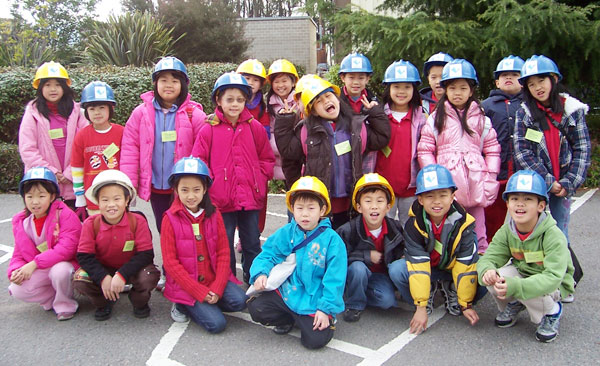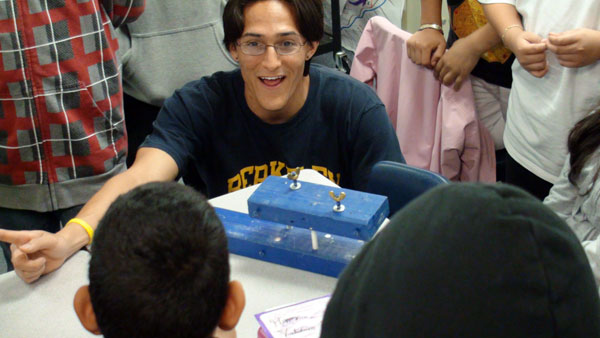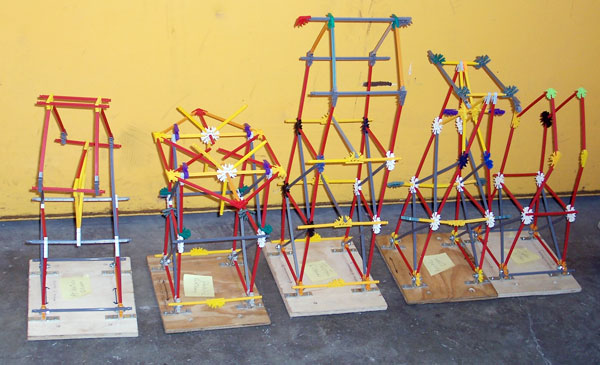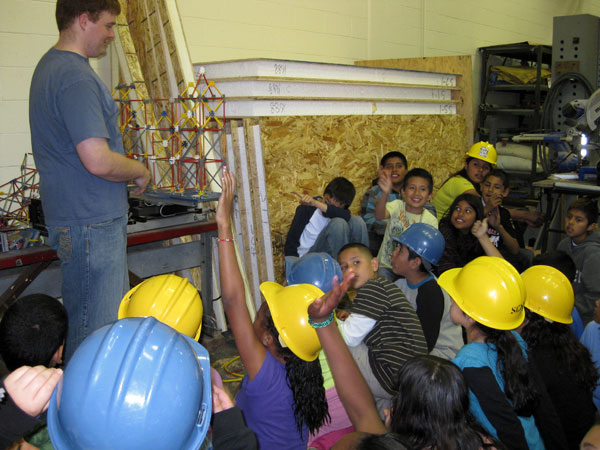2009–2010 K-12 Outreach Program
The 2009-2010 K-12 outreach program at UC Berkeley was extremely successful, reaching 20 schools, 35 classrooms, and 1005 students. This program is supported jointly by the PEER Center and the nees@berkeley laboratory.

The goal of the outreach program is to engage the students and foster interest in earthquakes and engineering. This was accomplished through a three part program.
The first part was a classroom presentation performed by one of two PEER instructors, either Justin Hollenback (UC Berkeley PhD student) or Jonathan Buckalew (UC Berkeley masters student). The presentation focused on earthquake engineering topics including concepts like: "where do earthquakes come from?", "how are earthquakes measured?", "what professions address the effects of earthquakes on our communities and buildings?", "how can I remain safe in an earthquake?", and "what elements help buildings resist earthquake shaking safely?"
The second part of the program involved constructing earthquake-resisting building models. PEER provided k'nex building kits for groups of 4-6 students. Each group was then asked to use information from the presentation to create an earthquake safe structure. This gave them the opportunity to participate in a hands-on engineering activity and develop team building skills.
The final piece of the program was a fieldtrip to UC Berkeley's Richmond Field Station. The fieldtrip exposed the students to modern research facilities including the NEES hybrid simulation laboratory with its collection of specimens on its reconfigurable reaction wall and the Earthquake Simulator Laboratory—the full scale shaking table. After the lab tour, the students' k'nex building models were tested on a small scale shaking table to see how well the student designs performed.
The 2009-2010 program increased its impact beyond what had been achieved in previous years. The number of instructors increased from one to two and the number building kits were doubled from eight to sixteen sets. These improvements are reflected in this year's final numbers: the program was able to connect to more schools (increase from 13 to 20) and classrooms (increase from 22 to 35) than last year.
Evidence of the success of the program can be shown by student and teacher quotes from the evaluations completed after the program.
"When I grow up I want to be an engineer." (Glenview Elementary, 2nd grade)
"The field trip was awesome!!" (Bella Vista Elementary, 4th grade)
"I think being an earthquake engineer is cool!" (Archway School, 4th grade)
"I learned that buildings are stronger with braces." (Glenview Elementary, 1st grade)
"My students had a fruitful learning experience from this program. I wish my next class will enjoy the same education program in the future. All in all, I feel privileged to have my students attend this field trip. Thank you again for your generosity and hard work in making this come true for us." (Lincoln Elementary, 3rd grade teacher)
Due to the success of this program it will be continued in 2010-2011. Learn more at the 2010-2011 program page.
The following shows the list of schools that participated in the 2009-2010 Program:
- – Lincoln High School, San Francisco, 9th Grade, 3 classes, 105 students (November)
- – ASCEND School, Oakland, 6th Grade, 2 classes, 48 students (November)
- – Oakland School for the Arts, 10th Grade, 1 class, 20 students (December)
- – Garfield Elementary, Oakland, 5th Grade, 1 class 20 students (December)
- – Stege Elementary, Richmond, 3rd Grade, 3 classes, 52 students (December)
- – Lincoln Elementary, Oakland, 3rd Grade, 1 class, 21 students (January)
- – Bella Vista Elementary, Oakland, 4th Grade, 3 classes, 80 students (January)
- – Coliseum College Prep Academy, Oakland, 6th Grade, 1 class, 28 students (January)
- – Glenview School, Oakland, 1st and 2nd Grade, 2 classes, 41 students (January)
- – Archway School, Oakland, 4th Grade, 1 class, 13 students (January)
- – Cub Scout Pack 30, 10-12 yr old, 13 cub scouts (February)
- – Joaquin Miller Elementary, Oakland, 3rd Grade, 1 class, 26 students (February)
- – John Swett Elementary, Martinez, 1st Grade, 3 classes, 84 students (February)
- – Glenview Elementary, Oakland, 1st Grade, 2 classes, 40 students (March)
- – Markham Elementary, Oakland, 3rd Grade, 1 class, 20 students (March)
- – Hoover Elementary School, Oakland, 5th Grade, 2 classes, 40 students (March)
- – Nystrom Elementary, Richmond, 1st Grade, 2 classes, 35 students (April)
- – Washington School, San Leandro, 5th Grade, 2 classes, 60 students (April)
- – Learning Without Limits, Oakland, 5th Grade, 2 classes, 60 students (May)
- – National Student Leadership Conference, high school students from various schools, 2 sessions of 100 students (June & July)

Lincoln Elementary is excited to learn about earthquakes!

A drawing of the fieldtrip by a 1st grader at Glenview School in Oakland

Justin Hollenback uses a demonstration to show why concrete columns are designed with reinforcement.

Sample structures built by students

Jonathan Buckalew answers questions before the shaking table test begins

A drawing of the shaking table test by a 1st grader at Glenview School in Oakland

